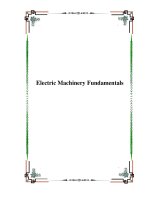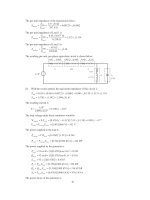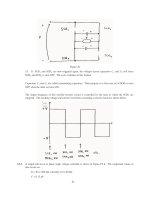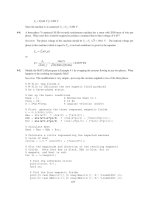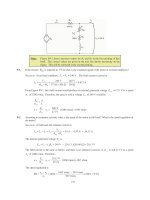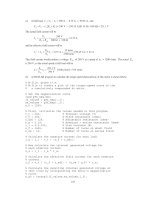Lecture 1 electric machinery fundamental
Bạn đang xem bản rút gọn của tài liệu. Xem và tải ngay bản đầy đủ của tài liệu tại đây (626.67 KB, 41 trang )
Advanced Power Systems
Dr. Kar
U of Windsor
Dr. Kar
271 Essex Hall
Email:
Office Hour: Thursday, 12:00-2:00 pm
/>
GA: TBA
B20 Essex Hall
Email: TBA & TBA
Office Hour: -----
Course Text Book:
Electric Machinery Fundamentals by Stephen J. Chapman, 4th Edition,
McGraw-Hill, 2005
Electric Motor Drives – Modeling, Analysis and Control by R. Krishnan
Pren. Hall Inc., NJ, 2001
Power Electronics – Converters, Applications and Design by N. Mohan, J.
Wiley & Son Inc., NJ, 2003
Power System Stability and Control by P. Kundur, McGraw Hill Inc., 1993
Research papers
Grading Policy:
Attendance
Project
Midterm Exam
Final Exam
(5%)
(20%)
(30%)
(45%)
Course Content
Working principles, construction, mathematical modeling,
operating characteristics and control techniques for
synchronous machines
Working principles, construction, mathematical modeling,
operating characteristics and control techniques for
induction motors
Introduction to power switching devices
Rectifiers and inverters
Variable frequency PWM-VSI drives for induction motors
Control of High Voltage Direct Current (HVDC) systems
Exam Dates
Midterm Exam:
Final Exam:
Term Projects
Group 1:
Student 1 ()
Student 2 ()
Student 3 ()
Project Title:
Group 2:
Student 1 ()
Student 2 ()
Student 3 ()
Project Title:
Group 3:
Student 1 ()
Student 2 ()
Student 3 ()
Synchronous Machines
Construction
Working principles
Mathematical modeling
Operating characteristics
CONSTRUCTION
Salient-Pole Synchronous Generator
1. Most hydraulic turbines have to turn at low speeds
(between 50 and 300 r/min)
2. A large number of poles are required on the rotor
d-axis
Nonuniform airgap
N
D ≈ 10 m
q-axis
Turbin
e
Hydro (water)
Hydrogenerator
S
S
N
Salient-Pole Synchronous Generator
Stator
otor
r
e
l
o
t-p
Salien
Cylindrical-Rotor Synchronous Generator
Stator
Cylindrical rotor
Damper Windings
Operation Principle
The rotor of the generator is driven by a prime-mover
A dc current is flowing in the rotor winding which
produces a rotating magnetic field within the machine
The rotating magnetic field induces a three-phase
voltage in the stator winding of the generator
Electrical Frequency
Electrical frequency produced is locked or synchronized to
the mechanical speed of rotation of a synchronous
generator:
fe =
nm P
120
where fe = electrical frequency in Hz
P = number of poles
nm= mechanical speed of the rotor, in r/min
Direct & Quadrature Axes
d-axis
Stator winding
N
Uniform air-gap
Stato
r
q-axis
Rotor winding
Rotor
S
Turbogenerator
PU System
Per unit system, a system of dimensionless parameters, is used for
computational convenience and for readily comparing the performance
of a set of transformers or a set of electrical machines.
PU Value =
Actual Quantity
Base Quantity
Where ‘actual quantity’ is a value in volts, amperes, ohms, etc.
[VA]base and [V]base are chosen first.
I base =
[VA ] base
[V ] base
Pbase = Qbase = S base = [VA ] base = [V ] base [ I ] base
Rbase = X base = Z base
Ybase =
Z
PU
[ I ] base
[V ] base
=
Z
ohm
Z base
2
2
[V ] base [V ] base
[V ] base
=
=
=
[ I ] base S base [VA ] base
Classical Model of Synchronous Generator
The leakage reactance of the armature coils, Xl
Armature reaction or synchronous reactance, Xs
The resistance of the armature coils, Ra
If saliency is neglected, Xd = Xq = Xs
jXs
jXl
Ra
+
+
E δ
Ia
Vt
0o
Equivalent circuit of a cylindrical-rotor synchronous machine
Phasor Diagram
q-axis
E
IaXs
δ
φ
IaRa
Ia
d-axis
Vt
IaXl
The following are the parameters in per unit on machine rating of a 555
MVA, 24 kV, 0.9 p.f., 60 Hz, 3600 RPM generator
Lad=1.66
Laq=1.61
Ll=0.15
Ra=0.003
(a)When the generator is delivering rated MVA at 0.9 p. f. (lag) and rated
terminal voltage, compute the following:
(i) Internal angle δi in electrical degrees
(ii) Per unit values of ed, eq, id, iq, ifd
(iii) Air-gap torque Te in per unit and in Newton-meters
(b) Compute the internal angle δi and field current ifd using the following
equivalent circuit
Direct and Quadrature Axes
The direct (d) axis is centered magnetically in the center of the north pole
The quadrature axis (q) axis is 90o ahead of the d-axis
θ: angle between the d-axis and the axis of phase a
Machine parameters in abc can then be converted into d/q frame using θ
Mathematical equations for synchronous machines can be obtained from
the d- and q-axis equivalent circuits
Advantage: machine parameters vary with rotor position w.r.t. stator, θ,
thus making analysis harder in the abc axis frame. Whereas, in the d/q
reference frame, parameters are constant with time or θ.
Disadvantage: only balanced systems can be analyzed using d/q-axis
system
d- and q-Axis Equivalent Circuits
+
Rfd
+
pψkd1
+
-
-
pψfd
vfd
ψq
Xl
Xfd
Ifd
Ikd1
Ra
Id
Imd
Rkd1
Xmd
Vtd
p ψd
Xkd1
-
d-axis
Imd=-Id+Ifd+Ikd1
− ψd
Xl
+
pψkq1
-
Ikq1
Rkq1
Ra
Imq=-Iq+Ikq1
Iq
Imq
Xmq
p ψq
Xkq1
q-axis
Vtq
Small disturbances in a power system
o
o
o
Gradual changes in loads
Manual or automatic changes of excitation
Irregularities in prime-mover input, etc.
Importance of steady-state stability
o
Knowledge of steady-state stability provides valuable information about
the dynamic characteristics of different power system components and
assists in their design
- Power system planning
- Power system operation
- Post-disturbance analysis
Related Terms
o
o
o
o
o
o
o
Generator Modeling using the d- and q-axis equivalent circuits
Transmission System Modeling with a RL circuit
A Small Disturbance is a disturbance for which the set of equations
describing the power system may be linearized for the purpose of
analysis
Steady-State Stability is the ability to maintain synchronism when the
system is subjected to small disturbances
Loss of synchronism is the usual symptom of loss of stability
Infinite Bus is a system with constant voltage and constant frequency,
which is the rest of the power system
Eigen values and eigen vectors are used to identify system steady-state
stability condition
The Flux Equations
(
)
ψ d = − X md + X l id + X md ikd1 + X md i fd
(
)
(
)
ψ kd1 = − X md id + X md + X kd1 ikd1 + X md i fd
(
)
ψ fd = − X md id + X md ikd 1 + X md + X fd i fd
(
)
ψ q = − X mq + X l iq + X mq ikq1
(
)
ψ kq1 = − X mq iq + X mq + X kq1 ikq1
